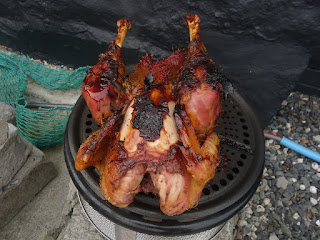 |
| One of our four too many |
The position becomes tenuous when you consider that not a few of those too squeamish to eat their own chickens will quite happily purchase a supermarket chicken or choose a chicken dish on a restaurant menu. Chances are, those birds will have had a far less pleasant existence than the ones you've reared and kept at home.
Examined honestly, it ends up looking less like a decision made in the interests of chicken-kind as a whole and more as a taking of the easy way out for oneself. The killing and butchering of an animal (particularly one that you may be fond of) is not a task relished by the sane. To my way of thinking though, it is a task that any eater of meat ought to be able to cope with on a conceptual level at least and on a practical level if you're in a position to do so.
Provided you can do the deed humanely and efficiently, eating your own chickens makes a lot of sense. This is particularly so if you hatch eggs to keep your flock going. There's always an excess of cockerels. Keeping more than one cock bird in a flock of less than around a dozen is no kindness to any of them. A cock of four or five month's age on the other hand makes delicious eating. Even a hen who has come to the end of her laying career will yield a succulent and nutritious batch of chicken soup.
The first time we hatched a batch of eggs, we hit it lucky. Out of eight eggs in the incubator, five hatched and only one was a boy. Second time around, the hatch rate was seven out of ten, but four of them were boys! Including their dad, therefore, we were ending up with at least four cockerels too many.
As the boys reached maturity, things in the flock started getting ugly and chicken was very much on the menu.
 |
| Our cone. Found on the beach and cut to size |
It's an inescapable fact that the killing of a chicken, by whichever humane method, is accompanied by quite a lot of tremendously powerful flapping. This is caused by muscle spasms that occur at the point of death and, though not indicative of suffering, can be distressing to witness as well as messy and bruising to the meat. Popping the bird into the cone, either immediately post- ('off with his head' or neck pull) or pre- ('go for the jugular') slaughter, eliminates this problem very effectively.
 |
| An old iron makes a good weight |
 |
| Nearly ready for the pot |
I don't propose to go into the nitty gritty of butchering here. I may do so in a later post, but for those needing the information, there are good YouTube videos out there and at least one really excellent book.
 |
| BBQ |
 |
| Southern fried chicken |
If you're an omnivore, gird your loins and get on with it. It's not an easy thing to do, but it does get easier with practice. It completes the circle of chicken keeping and reminds us of what it means to be an animal, part of a food chain and the web of life on earth.
Very cool Jim. ...you are an excellent writer. .also Congrats to Sonja on her sailing cookbook! Simon super impressed!
ReplyDeleteVery kind of you Heather, thank you. :-)
Delete